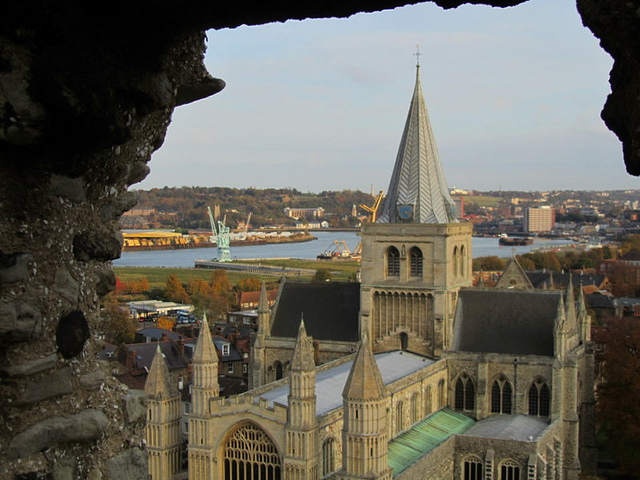 Cliffe Pools Nature Reserve
Cliffe Pools Nature Reserve Dickens Glads Hill Place
Dickens Glads Hill Place  Eastgate House - Dickens Centre
Eastgate House - Dickens Centre Guildhall Museum
Guildhall Museum Restoration House
Restoration House Rochester Castle
Rochester Castle Rochester Cathedral
Rochester Cathedral Six Poor Travellers House
Six Poor Travellers House
The church of St. Andrew the Apostle, Rochester was founded by Ethelbert, King of Kent, as a college for a small number of secular canons under Justus, Bishop of Rochester in AD 604. Very little is known about the history of this house. It never seems to have had much influence outside its own walls and though it possessed considerable landed estates, seems to have been relatively small and poor. It also suffered at the hands of the Danes. Bishops Justus, Romanus, Paulinus and Ithamar were all remarkable men but after Bishop Putta's translation to Hereford in AD 676, very little is heard of Rochester. Bishop Siweard is not mentioned as having been at Hastings with King Harold, as were many of the Saxon bishops and abbots. The house put up no opposition to King William I when he seized its lands and gave them to his brother Odo, Bishop of Bayeux, whom he had created Earl of Kent. The chroniclers say that the house was destitute and that when Siweard died in 1075, it was barely able to support the five canons on the establishment.
In 1083 Lanfranc, Archbishop of Canterbury, visited Rochester and himself instituted 22 monks of the Benedictine order in the house: some from Bec, France, probably some from the two houses at Canterbury, Christchurch and St Augustine, and possibly some from Caen. He endowed the house with property, making careful and distinct provision for the bishop and the monks. Some of the lands he gave them were his own, others he bought and some he had acquired in 1076. Gundulf, Bishop of Rochester, also acquired a great deal of property for his house, which rapidly found favour with the Norman kings. Together with Archbishop Lanfranc, he began the rebuilding of the church and monastery buildings. In the rebuilding of his church, Gundulf followed the usual practice of starting the new building to the east of the existing church so that there would be no interruption in the services of the church. He also appears to have incorporated part of the city wall into his building, as the tower known as Gundulf's Tower was one of the watch towers. Substantial parts of his work remain today, particularly in the crypt.
William of Perth
Gifts of property, lands and rents to St. Andrew's Priory, Rochester were numerous, particularly in the early years and again in the 13th century. The first upsurge of giving was in the time of Lanfranc and Gundulf. The second probably coincides with the murder of William of Perth in 1201 and his subsequent canonisation in 1256. William was a Scottish pilgrim who was murdered shortly after leaving Rochester following a brief stay at the Priory. It mattered little who he was or why he was murdered. Every religious house at some time or other needed an impetus to improve its finances and its worth in the eyes of the world and the possession of the shrine of a saint to which pilgrims could come and worship was as good a way as any other. Canterbury profited richly from the tomb and shrine of Thomas Becket but until 1256, Rochester had nothing similar to offer would-be pilgrims and benefactors. There is no evidence that a special officer was appointed to deal with the money and gifts offered at the tomb, however. The only reference to it is in the deed in the cathedral archives relating to John de Sheppey's charity, which was nearby.
The Reformation
The Cathedral priory of St Andrew the Apostle, Rochester, was technically surrendered into the hands of the Crown on 20 Marc
No Comments Yet - Why not be the first to leave a comment
Every effort is made to make sure that all the information is correct but we strongly recommend that you call Rochester Cathedral before you set off on your day out to confirm opening times and admission prices.
Please also note that the position on Google maps for Rochester Cathedral is a rough estimate using their postcode in the database and might be slightly out.
It may also be worth clicking the web link for Rochester Cathedral to see if there are any special events coming up or currently on.